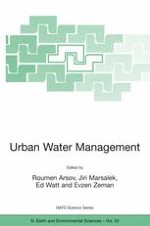2003 | OriginalPaper | Buchkapitel
Low Lime Coagulation for the Enhancement of Primary Treatment of Urban Wastewater
verfasst von : D. Marani, R. Ramadori, A. C. Di Pinto, R. Passino
Erschienen in: Urban Water Management: Science Technology and Service Delivery
Verlag: Springer Netherlands
Enthalten in: Professional Book Archive
Aktivieren Sie unsere intelligente Suche, um passende Fachinhalte oder Patente zu finden.
Wählen Sie Textabschnitte aus um mit Künstlicher Intelligenz passenden Patente zu finden. powered by
Markieren Sie Textabschnitte, um KI-gestützt weitere passende Inhalte zu finden. powered by
Pollutants in municipal sewage include a complex mixture of soluble and insoluble constituents ranging in size from less than 0.001 μm up to over 100 μm [1]. Several studies have been addressed to the classification of contaminants in wastewater in terms of particle size. Balmat [2], Heukelekian and Balmat [3] and Rickert and Hunter [4], using a sequence of sedimentation, centrifugation and filtration, separated the contaminants into four size fractions: settleable (> 100 μm), supracolloidal (1–100 μm), colloidal (0.08–1 μm), and soluble (< 0.08 μm). On the basis of a sequential filtration of the wastewater, Munck et al. [5] used a slightly different definition of the four size ranges: settleable (> 106 μm), supracolloidal (3-106 μm), colloidal (0.025–3 μm), and soluble (< 0.025 μm). Notwithstanding the differences in the operating definition of the size ranges, these studies do agree that only a quarter or less of the COD of the raw sewage may be considered truly soluble [6]. The majority of the pollutant load is actually in suspended form, and is not easily biodegradable. In addition, other contaminants, such as heavy metals, bacteria and viruses, and organic micro pollutants (PCB, PAH) are strongly associated with the suspended phase.
